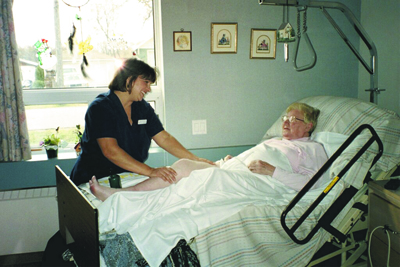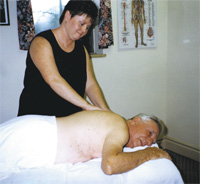
Features
Practice
Technique
Geriatric Treatment
The population is aging. The baby boomer generation, the largest of its kind, is now entering its “golden” years. The number of people age 65 and over is expected to double from nearly 4 million in 2000 to almost 8 million by 2026.
September 16, 2009 By Sheila Savary
The population is aging. The baby boomer generation, the largest of its kind, is now entering its “golden” years. The number of people age 65 and over is expected to double from nearly 4 million in 2000 to almost 8 million by 2026.
This could lead to the conclusion a career in geriatric massage therapy would be lucrative. However, careful consideration is required before entering into this specialized field.

|
|
|
Since December 1998, I have had the good fortune to have a contract with The Middlechurch Home of Winnipeg, a personal care home north of Winnipeg.
Working with the elderly has many advantages. If you love physiology and pathology (as I do), the opportunities to explore and understand are enormous. Every moment of every day that I’m working with the aged, I learn more about the human body, the human condition, and myself, than I had ever thought possible.
The daily working environment is much different than working in my massage therapy clinic. Working at a personal care home requires adaptability, to say the least. Everything from scheduling appointments to the application of the treatment has to be adapted to fit the needs of the resident. Massage therapy should enrich their weekly routine, not replace something else they enjoy because it fits into the therapist’s schedule.
As they say, “timing is everything.” If the resident is in a wheelchair, scheduling should include the time necessary to have one or two health care aides to assist them into their bed for massage. Health care aides are necessary for lifting and assisting the residents as they have the full coverage necessary with the personal care home’s insurance for this task.
You must also consider that appointments will be cancelled at the last minute for a variety of reasons. For this reason, I schedule appointments quite close together.
Often, residents have given power of attorney to a loved one. This requires the contact of this person, usually the son or daughter, regarding the massage therapy program. They will then approve treatment and arrange for payment. Most residents have trust accounts with the personal care home and, once approval has been obtained, the accounts may be billed directly. Talking with families is one of the bonuses of my job – they love to hear how mom/dad/grandma/grandpa is doing.
There are specific responsibilities one must carry out when working at the personal care home. There should be open communication with family members and staff, and flexibility with scheduling, as mentioned above.
Therapists are required to report observed concerns to the health care professional on duty – e.g. increase in edema, skin discolorations, changes in moles, changes in personality/ mood, increase/decrease in rigidity/ tremor etc. These observations should be documented in clients’ charts as well. Be conscientious in thought, place yourself in the resident’s position and be aware of their comfort and care before during and after the massage treatment.

|
|
|
|
Hypertension, congestive heart failure, osteoarthritis, diabetes, dementia, declining tissue integrity, and paralysis are some of the many conditions that are seen when working with the elderly. Contraindications are dealt with somewhat differently than in the younger population.
It requires weighing the benefits against the possible negative effects. Being familiar with these, as well as
a host of other conditions, will make your treatment more effective.
Understanding the medical abbreviations will also speed things up when charting, these are used with frightening regularity!
Incontinence pads are a fact of life working in a personal care home. Pads come in many forms, depending on the type of incontinence. Often, when performing a massage, they will become soiled. This now becomes a matter of choice for the therapist.
You may halt the massage at this point and have a health care aide attend the resident, or, continue
if at all possible. It is key to remember at this point that constipation is a far too common and painful condition among the elderly and a bowel movement during a massage is a small price to pay for the relief of it.
When gathering information for this article, I looked at the “numbers” over the years. We often hear that women outlive men – from my very tiny study, this is true. Females make up 76 per cent of all the residents I have treated. The average age is in the over 85 category – 58 per cent. The average number of treatments per resident came out to 28. Residents like to have and also need their massage on a regular basis.
For best results, a minimum of once a week is recommended.
If you are considering approaching a personal care home about setting up a massage therapy program I believe there are two key criteria.
1) The massage therapy program must be self-sufficient. The board of the personal care home will not
be able to approve a program that will cost them money!
2) In the referral process, all caregivers should be able to refer the resident for massage, as well as the resident them self.
Of course, there are aspects of working in this field which cannot be ignored. Of all of the residents who have received massage treatment since December of 1998, 47 per cent have passed away. I would have to say that this is the hardest part of my job. The residents do become a part of my extended family. You hear talk of professional detachment, this is very difficult in the setting of a personal care home. Home is the key word, and home means family. I was able to attend a course offered here by Hospice and Palliative Care Manitoba – “A Friend in Hand.”
This 8-week course explores attitudes toward death and dying. I would advise anyone who is thinking of working in the geriatric field to consider a course of this nature.
Print this page